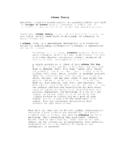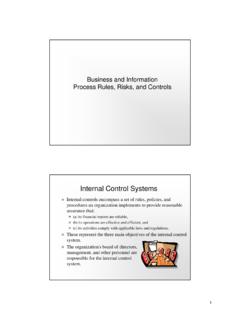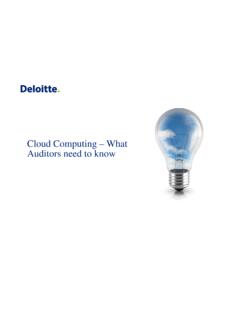Transcription of Industry Analysis: Cloud Computing - Sacramento State
1 Industry analysis : Cloud Computing Complied by Group: MIS Majors BoYee Au-Yeung | Dave Chu | Mark Enfante | Graham Logan | Kevin Saelee GM 105 Industry analysis | 2 Cloud Computing Table of Contents Introduction .. 3 Background .. 4 Dominant Economic Characteristics .. 5 Six Forces of Competition .. 19 Competitive Position of Major Companies and Competitor 27 Key Success Factors .. 38 Industry Prospects and Overall Attractiveness .. 42 Conclusion .. 44 References .. 45 GM 105 Industry analysis | 3 Cloud Computing Introduction Cloud Computing is a term used to convey the complex, distributed exchange of data and resources over a network.
2 The most famous of networks is the internet, but companies, governments, and individuals can even create their own network for distributed resource access. To better understand the power of Cloud Computing , as enabled by virtual machines and distributed Computing resources, it s prudent to understand the components of an integrated network. There are clients which are typically end user computers like laptops and workstations that connect to servers. The physical connection, either through radio waves ( wireless) or through Ethernet is the distribution path of the network. The network is a logical construct physically implemented by connecting wires, switches and routers that direct the flow of data traffic, and firewalls that control access to different hierarchical access levels logically segmented for security purposes.
3 Now, utilization of this physical construct, logically separated by security protocols, can be accomplished by minimizing the data flow from the client to the server and back again from the server to the client. Having the client ask for data in a message and then sending that message to the server where the processing is done is faster than the client trying to ask for the entire data set to be transferred over the network. The centralization of data processing is where the virtual machines come into play. Virtual machines are nothing more than another logical construct used to segment physical processing power and data storage into logically distinct computer environments.
4 The ability to allocate processing power and data storage dynamically to logically distinct computers is reason that Cloud Computing is so powerful. With the advent of server farms essentially a giant warehouse where thousands of servers are housed and linked together Cloud Computing was not far behind. The Computing power required to manage the copious amount of data necessitated the advent of server farms. The management of these server farms required the dynamic allocation Computing resource and data storage. Today Facebook, Amazon, and Google are some of the organizations that utilize the power afforded by aggregated virtual machines known as the Cloud .
5 GM 105 Industry analysis | 4 Cloud Computing Background Cloud Computing has taken on science fiction connotations and is thought to be a relatively new concept. However, the idea behind aggregating distributed Computing power has been in the minds of technological innovators for decades. The idea of an intergalactic computer network was introduces in the 60 s by Licklider, who was responsible for enabling the development of Advanced Research Projects Agency Network (ARPNET) in 1969. [1]. Although a radical idea at that time, a vision of an interconnected global network able to access data from wherever whenever is something we now could not function without.
6 In the 1970 s IBM was the first company to release an operating system called VM heralding the birth of the term virtual machine. The VM operating system allowed for multiple virtual systems on a physical host. Fast-forward to 1997, a University of Texas professor Ramnath Chellappa coined the term Cloud Computing . In 1999 and we find a small startup company pioneering the concept of utilizing distributed Computing power to deliver enterprise applications via a simple website. [1]. Harnessing the power of aggregated Computing power ( Cloud Computing ) was just the first step in developing the power of the Cloud .
7 The next iteration was introduced by Amazon in 2002 with Amazon Web Services. These services included storage, computation, and other offerings. In 2006 Amazon launched its Elastic Compute Cloud (EC2) as a commercial web services that allows small companies and individuals to rent computers on which to run their own computer applications. [1]. In 2009 Google added to the continuing exponential growth of Cloud Computing adoption by offering browser-based enterprise applications. As the public attention turns toward the newest technology trend adoption rates of Cloud Computing platforms will continue to increase.
8 However, like most technologies Cloud Computing has been around for decades. GM 105 Industry analysis | 5 Cloud Computing Dominant Economic Characteristics Market Size The market size of the Cloud Computing Industry continues to show robust growth. If adoption tends persist, then expenditures a forecasted to reach nearly $70 billion USD annual expenditures in 2016 for worldwide consumption of just the applications that utilize Cloud Computing . That s roughly a 250% gain from 2011. With the introduction of more powerful computer hardware and software that enables the logical separation of the Computing power into virtual machines the Cloud Computing market will continue to grow.
9 The only hindrance to the continued growth of this market will be the availability of skilled professional available for organizations to hire. The limited talent pool that has the capabilities to implement and administer the complexities of Cloud based Computing does not seem to impact the surveyed expectations of organizations spending on Cloud Computing systems. As the graph shows the forecasted global spending on enterprise Cloud architecture, which is the actual physical component of Cloud Computing , is expected to reach nearly $250 billion USD by 2017 [1]. GM 105 Industry analysis | 6 Cloud Computing Scope of Competitive Rivalry The Cloud Computing Industry is varied and nuanced with each competitor offering niche services.
10 Depending on what the consumer trend will be over the long run many of these offering will be phased out. Google, Microsoft, Red Hat, and SalesForce are the predominant organizations that offer Cloud based enterprise solutions. Google Google will continue to be the most utilized search engine and search analystics provider in the world. With the adoptionof niche services and platforms Google can capture a slice of the gorwing clod Computing market. From the Gartner Magic Quadrant analysis [2]: Google's large installed base (it claims 30,000 paying customers) consists of many small Web innovators and some very large Web business sites (such as Snapchat and Khan Academy).











